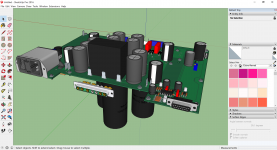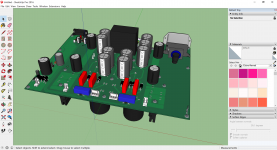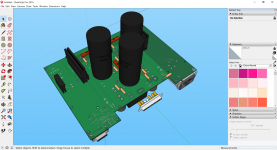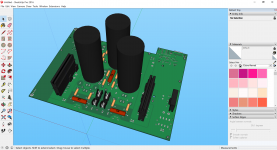Nice work , to each his own , i usually build 845SE amps , but the latest production of 845B and C , is a disaster , tubes arrive already slightly gassy , you can see the getter is starting to fade away without even having run the tubes . Ordered 845B from china and frm collegue hoping he had older production......all same problem......so looking into GM70 for next project , how do you recognise the factory ?
Wow, this is a shame of course, but all in line w/commercial tube Chinese policy, Thanks for inform.
By what I know GM70 graphite plate and copper plate are all from Ulianov state factory, the rare metal plate was from Photon plant in Tashkent city and its base was not alu, but a nice golden metal, maybe bronze.
GM70 is a military tube and Russian take serious the military equipment.
More info here:
About the GM70 Vacuum Tube.
And if you translate Russian try here plenty of Russian info down the page:
??70 < ?? < ??????? < ????? < ???????? < ???????????? < AudioDB : ???? ?????? Audio
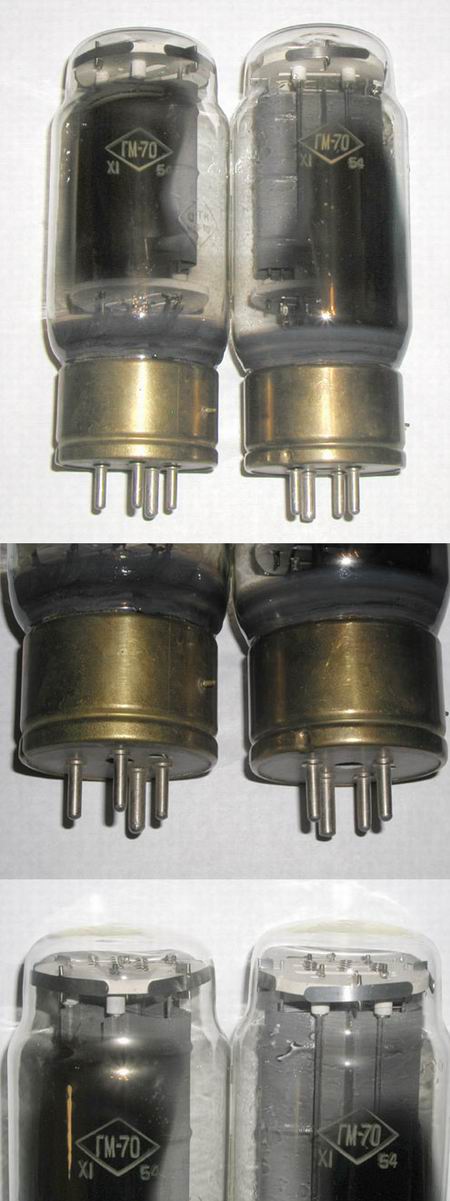
By what I know GM70 graphite plate and copper plate are all from Ulianov state factory, the rare metal plate was from Photon plant in Tashkent city and its base was not alu, but a nice golden metal, maybe bronze.
GM70 is a military tube and Russian take serious the military equipment.
More info here:
About the GM70 Vacuum Tube.
And if you translate Russian try here plenty of Russian info down the page:
??70 < ?? < ??????? < ????? < ???????? < ???????????? < AudioDB : ???? ?????? Audio

Last edited:
Interesting, yet somewhat controversial information in the Russian link. This is a compilation from data sheets and web discussion groups. The main points:
- You cannot get good sound out of GM70;
- GM70 is the best sounding of all power triodes;
- GM70 is good with mid-bass and mids, but not highs;
- Graphite plate tubes sound better and are more reliable than copper plate ones;
- Optimal load is 6-8 K;
- GM70 sounds good at voltages as low as 800 V;
- Lower heater voltages don't work, but 21 - 21.5 V sounds better than 20 V. These higher heater voltages are well tolerated, but voltage must be stabilized;
- Base connections are problematic, poor connection may cause poor sound. Base can be removed and connections re-soldered.
- You cannot get good sound out of GM70;
- GM70 is the best sounding of all power triodes;
- GM70 is good with mid-bass and mids, but not highs;
- Graphite plate tubes sound better and are more reliable than copper plate ones;
- Optimal load is 6-8 K;
- GM70 sounds good at voltages as low as 800 V;
- Lower heater voltages don't work, but 21 - 21.5 V sounds better than 20 V. These higher heater voltages are well tolerated, but voltage must be stabilized;
- Base connections are problematic, poor connection may cause poor sound. Base can be removed and connections re-soldered.
I have a pair of GM70 amps I designed and built quite a while ago.
My observations are as follows:
My observations are as follows:
- Sound good at 1kV
- Don't sound so good at 800V
- 6 - 8K is good for low distortion
- 5K maximizes output power
- Last about 1200 hours with CCS based filament supplies. They do not sound good after this point
- Have never lost a filament
- Graphite (Ulianov and Reflector) are more authoritative in the bass, more neutral perhaps than copper plate
- Copper plate has nice mids, and highs, a little less control on the bottom end (higher rp?)
- Copper plate do not like as high dissipation, better not to exceed 100W pd
- Some make alarming brush noise and clinking/clanking during warm up
- Hard on sockets.
- Corona noise that never goes away during warm up in some tubes and others are silent
- They exhibit good linearity
- Figure on at least 200Vpp drive capability if you want power.
- In A1 plate will not swing much below half supply before you are in grid current territory and A2 operation. (On 1kV supply you can swing roughly 1kVpp on the plate before A2 operation)
- You can get ~20W into 7K load without leaving A1 at 1kV, something close to 25 - 30W is possible at 5K.
How do they say always ? (Low)Distortion eats power anytime.
I hardly can hear if my speaker is driven by 12W or 30W as most of the music is a t a very low Watt level.
I CAN hear though the effect of more current going through a tube. Not sure if this is here with the GM70 different and it need more vpoltage and not current ?
Ready Kevin's comments about 800V vs. 1000V. I planned to use 800V with more current as I have a lot of respect for 1000V and the weird things which can happen at that level. 800V is still high, but I believe 1000 is a borderline where things can become really different.
I hardly can hear if my speaker is driven by 12W or 30W as most of the music is a t a very low Watt level.
I CAN hear though the effect of more current going through a tube. Not sure if this is here with the GM70 different and it need more vpoltage and not current ?
Ready Kevin's comments about 800V vs. 1000V. I planned to use 800V with more current as I have a lot of respect for 1000V and the weird things which can happen at that level. 800V is still high, but I believe 1000 is a borderline where things can become really different.
I have played with various GM70, and conclusion is that they are different, among graphite plate ones, and different among copper plate ones. "Metal" plate as in the pictures above are unobtanium for already a long period.
Copper plate ones are always more vivid and transparent at highs, but usually not so good at bass. However, some of copper plate GM70 are good also at bass. One could be lucky in getting such tubes.
I personally use 800V and copper plate. Copper plate GM70 do not show substantial sound dependence on plate voltage, but graphite ones - do show.
Copper plate ones are always more vivid and transparent at highs, but usually not so good at bass. However, some of copper plate GM70 are good also at bass. One could be lucky in getting such tubes.
I personally use 800V and copper plate. Copper plate GM70 do not show substantial sound dependence on plate voltage, but graphite ones - do show.
A bit difficult to provide a scientific proof, but on DIY level I could mention, that if I replace GM70 and measure auto cathode bias voltage (that I have at my amp), I see that various tubes form substantially different bias voltages. The more auto bias voltage formed, the better sound (I think Ri is smaller for tubes with higher auto bias voltages). Some copper plate tubes have bias voltage higher than all graphite plate tubes that I have. And with these copper plate tubes, sound is the best, at highs and at bass.
Different bias points correlate to tolerances in tube manufacturing. So, if one claims "copper" tubes do sound this way, "graphite" ones that way, and "other metal" plate tubes yet another way, and deduces the sonic qualities from bias aspects, this by itself has to be deduced to equal tolerances within the make of copper, graphite or other metal plate tubes, respectively, not to the plates' material per se (as copper, graphite and other metals don't sound at all).
And if different tubes of the same type do indeed sound differently, the amplifier's design supposedly is inferior, e.g. lacks some significant NFB. Or the "difference" in sound can be deduced to expectation bias.
Best regards!
And if different tubes of the same type do indeed sound differently, the amplifier's design supposedly is inferior, e.g. lacks some significant NFB. Or the "difference" in sound can be deduced to expectation bias.
Best regards!
If you remove the GM70 nice alu base you can use a cheap reliable Russian bakelite socket from the 6C33.Interesting, yet somewhat controversial information in the Russian link. <snip>

thorium emision is less than oxides
but longevity should be better
My understanding is that these are straight tungsten and not thoriated. They are very bright emitters. They also have quite short service lives.
I've had three other sets of coppers in the amps from various manufacturers, the current ones are the best I have had. I think they are Ulyanov, but I am not sure. (That would involve removing one and looking at it, which I will have forgotten about by tomorrow when I have time to look)
Have never seen any of the iron plate variations.
I have also had graphite plate. Some very good indeed, close in the highs to copper and slightly better control in the bass.
My amps are fixed bias so I am not able to make the correlations made in a previous post. I have not found any that were not completely satisfactory.
Just for your information: I measure with my curve tracer (Roetester V9) four pairs of GM-70, NOS which I got as NOS from ebay, measured at 600V, -42V
Foton Graphite plate:
1. Ia=127mA, S=4,1ma/V, mu=7,3, Ri=1,8k
2. Ia=134mA, S=5,5ma/V, mu=7,5, Ri=1,6k
Copper-Plates:
1. Ia=108mA, S=4,6ma/V, mu=8,6, Ri=1,8k
2. Ia=123mA, S=4,25ma/V, mu=8,1, Ri=1,8k
3. Ia=126mA, S=4,8ma/V, mu=8, Ri=1,7k
4. Ia=126mA, S=4,8ma/V, mu=8,1, Ri=1,7k
Iron-Plates:
1. Ia=113mA, S=3,25ma/V, mu=7,1, Ri=2,1k
2. Ia=131mA, S=3,38ma/V, mu=7,4, Ri=1,8k
Soooo...not really much different from a parameter view...I guess we hear more the way it was constructed if they sound different...
Foton Graphite plate:
1. Ia=127mA, S=4,1ma/V, mu=7,3, Ri=1,8k
2. Ia=134mA, S=5,5ma/V, mu=7,5, Ri=1,6k
Copper-Plates:
1. Ia=108mA, S=4,6ma/V, mu=8,6, Ri=1,8k
2. Ia=123mA, S=4,25ma/V, mu=8,1, Ri=1,8k
3. Ia=126mA, S=4,8ma/V, mu=8, Ri=1,7k
4. Ia=126mA, S=4,8ma/V, mu=8,1, Ri=1,7k
Iron-Plates:
1. Ia=113mA, S=3,25ma/V, mu=7,1, Ri=2,1k
2. Ia=131mA, S=3,38ma/V, mu=7,4, Ri=1,8k
Soooo...not really much different from a parameter view...I guess we hear more the way it was constructed if they sound different...
Interesting, could you please post a foto of iron plate tubes?Just for your information: I measure with my curve tracer (Roetester V9) four pairs of GM-70, NOS which I got as NOS from ebay, measured at 600V, -42V
Iron-Plates:
1. Ia=113mA, S=3,25ma/V, mu=7,1, Ri=2,1k
2. Ia=131mA, S=3,38ma/V, mu=7,4, Ri=1,8k
Soooo...not really much different from a parameter view...I guess we hear more the way it was constructed if they sound different...
Soooo...not really much different from a parameter view...I guess we hear more the way it was constructed if they sound different...
My words
I guess these sonic "observations" wouldn't stand a DBT either.
Best regards!
+1Interesting, could you please post a foto of iron plate tubes?
- Status
- This old topic is closed. If you want to reopen this topic, contact a moderator using the "Report Post" button.
- Home
- Amplifiers
- Tubes / Valves
- 845 vs GM70
